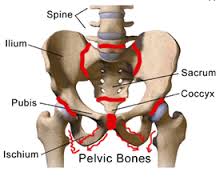What is this?
The pelvis is the bones that your spine rests on at the top and your hips come from at the sides. It is made of 3 bones which are held together by ligaments. There are many muscles which attach into these three bones. Pelvic pain, originating from the joints at the back is pelvic girdle pain (PGP) and these joints are called the sacroiliac joints (SIJ).
How does this happen?
Pelvic pain can come on with a number of different mechanisms but most commonly we see this during pregnancy or after some type of trauma. During pregnancy your hormone levels cause a change in your ligaments. This allows them to be not as tight and make room for your growing baby. This also makes them less effective at stabilising joints, especially round the pelvis. You also have more pressure down on the pelvis as the baby grows bigger which can cause more pain in the SIJ. Trauma where you land heavily on one side of your pelvis or have your leg tugged or compressed can cause problems in the SIJ as well. If left untreated for a period of time then this can cause all sorts of compensations of the surrounding muscles to try and protect and support the pelvis.
What does it feel like?
Pain is normally below the level of the low back. But it can spread around to the front of the pelvis (the pubic bone). During pregnancy people complain of aching or shooting pain which can travel down the back of the leg/s. Normally patients complain of a deep aching pain which is worse when they are immobile (sleeping or sitting) and then try to move. There is pain with running, kicking and twisting type activities. Any activity which requires the leg to move away from the mid-line also aggravates the pain. Patients often report that even after prolonged periods of rest the symptoms still come back again when they try to return to sport with no intervention by a physiotherapist.
How are they diagnosed?
Your physiotherapist is likely to diagnose groin pain by listening to your mechanism of injury or onset. They will also perform a series of specific tests looking at your back, pelvis and a number of different muscles. The hip, alignment and stability will also be determined to accurately differentiate conditions that could be causing the groin pain. They will palpate or feel where the pain is and what the different areas feel like compared the unaffected side. Generally further investigations are not necessary but sometimes X-rays or scans help to to rule out stress fractures.
What can Back in Action do to help?
Although resting is a key factor in the early phase of a groin strain. There are then many different things we can do to help firstly get rid of the pain. The next goal is to then regain your movement and finally stop it coming back again. When the cause of your pain has been discovered we will do such things as massage, mobilisations, taping, acupuncture (if required) and other manual therapy techniques.
We will identify areas of weakness and tightness and look at the biomechanics and loading of the whole lower limb. We will then start you on a specific home exercise program. It is important with a groin injury to have a clear idea of the short and long term goals. This allows us to find the contributing factor to be rehabilitated and then integrated in the final stages. This is when we do some sports specific training to enable you to return even better, faster.
Book in with us TODAY!

